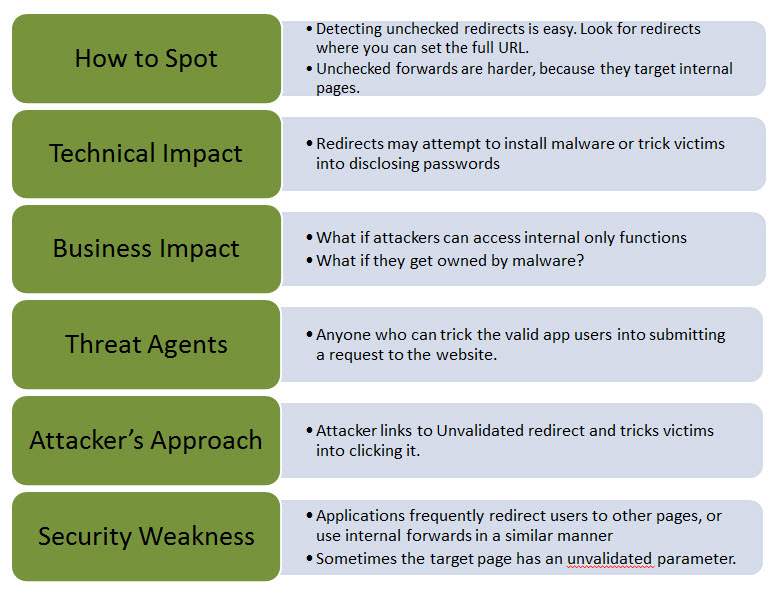Unvalidated Redirects¶
Written by Cody, Edited by Sara and Paul.
Introduction¶
Web applications often redirect and forward users to other pages and websites. Without proper validation of the data being used to determine the destination pages, attackers can redirect users to phishing or malware sites that may appear trustworthy. Unvalidated redirect and forward attacks can also be used to craft a URL to pass the application's access control check and forward the attacker to functions that they would normally not have access to. It is important that when working with redirects the programmer properly declare the URL so that it cannot be manipulated by an attacker. [owasp]
How Do Redirects Work?¶
The purpose of redirects is to send users to another page. The URL in a safe redirect must be explicitly declared so it is not manipulated by attackers. [owasp] A typical redirect might look like the following:
http://www.simpson.edu/redirect?url=http://simpsonstudentinfo.com
This redirect is just using a parameter, 'url' to decide the destination of the redirect. It may seem to be harmless as it is, but an attacker could easily use the redirect feature to send users to a different link. Such as:
http://www.simpson.edu/redirect?url=http://evilsimpsonstudentinfo.com
Which could then have the potential for the vulnerabilities and security risks mentioned later. But first, its important to understand where the risks are taking place and how they can be avoided. [cred]
How To Fix a Dangerous Redirect¶
In the previous section, I explained briefly how a redirect might look inside the URL, but what is going on behind the scenes that makes this vulnerability so risky?
Below is the Java code that receives the URL from the 'url' GET parameter (same as the example above) and redirects to that URL.
response.sendRedirect(request.getParameter("url"));
This code is vulnerable because no validation or controls have been applied to verify the certainty of the URL. If no validation is applied, an attacker could create a hyperlink to redirect users to a malicious site.
Instead, the vulnerability could easily be avoided by using the following:
response.sendRedirect("http://simpsonstudentinfo.com")
In this case, the URL is being explicitly declared and cannot be manipulated by attackers. [owasp]
Impacts of the Vulnerability¶
Redirects can a present a great security risk if they are not handled correctly Using a combination of malicious practice and social engineering, an attacker can trick the user into downloading malware, redirect them to a phishing site or even potentially gain access to unauthorized pages. One of the main reasons the user is so vulnerable is because the original website's name appears in the malicious URL convincing the user it is safe. Below are the different ways unvalidated redirects could potentially be vulnerable.
1. Technical Impact: As mentioned above, redirects may be used to install malware and spread viruses. This could be dangerous for the user, as it could do damage to their system. Redirects also may trick users into disclosing sensitive information without knowing. This could have a very large impact on some users because, although it is bad practice, most people reuse passwords for multiple websites, and so, they could become quite vulnerable with just one malicious redirect.
2. Business Impact: This impact is a little less technical, in the sense that, physical damage is not being done, but rather, business trust and relationships can be harmed. For example, if a user is taken advantage of by an attacker using a unvalidated redirect, there is going to be a loss of trust in that business's website. Therefore, leading to a loss in future business.
It is important to keep these vulnerabilities in mind if, and when, using redirects. The potential for an attacker to do harm to both users and the company's business is present. If redirects can be avoided, they should be. No business or website should have its user's trust in jeopardy with the possibility of malicious attacks. [cred]

Avoiding the Vulnerability¶
With the potential security risks that come into play with unvalidated redirects, its important to know that there are other ways to go about sending users to different web pages to avoid the vulnerability. Listed below are a few simple ways to avoid unvalidated redirects. [mtsu]
- Don't use redirects at all.
2. Don't involve parameters in calculating the destination. In other words, don't use user input to determine the destination.
3. If the destination parameters can't be avoided, be sure the supplied value is valid and authorized for the user.
Summary¶
In conclusion, it is apparent that unvalidated redirects bring about a potential for malicious attacks on websites and their users. With careful programming, these vulnerabilities can be avoided and prevent attackers from tricking users into giving away sensitive information or downloading malware. The cost of losing user trust and business is too great to risk this avoidable vulnerability.
Sources
| [owasp] | (1, 2, 3) Susanna Bezold, Johanna Curiel, Jim Manico. "Unvalidated Redirects and Forwards Cheat Sheet." OWASP, 20 Sept. 2016. Web. 20 Feb. 2017. |
| [kemp] | Maurice McMullin. "OWASP Top Ten Series: Unvalidated Redirects and Forwards." Kemp Technologies, 18 Apr. 2016. Web. 20 Feb. 2017. |
| [tp] | "Security Testing - Unvalidated Redirects and Forwards" TutorialsPoint. Web. 20 Feb. 2017. |
| [mtsu] | "Unvalidated Redirects and Forwards." Montana State University. Web. 20 Feb. 2017. |
| [cred] | (1, 2) Chris Gaskill. "Top 10 Web Security Risks: Unvalidated Redirects and Forwards (#10)." Credera, 16 Jan. 2014. Web. 27 Feb. 2017. |